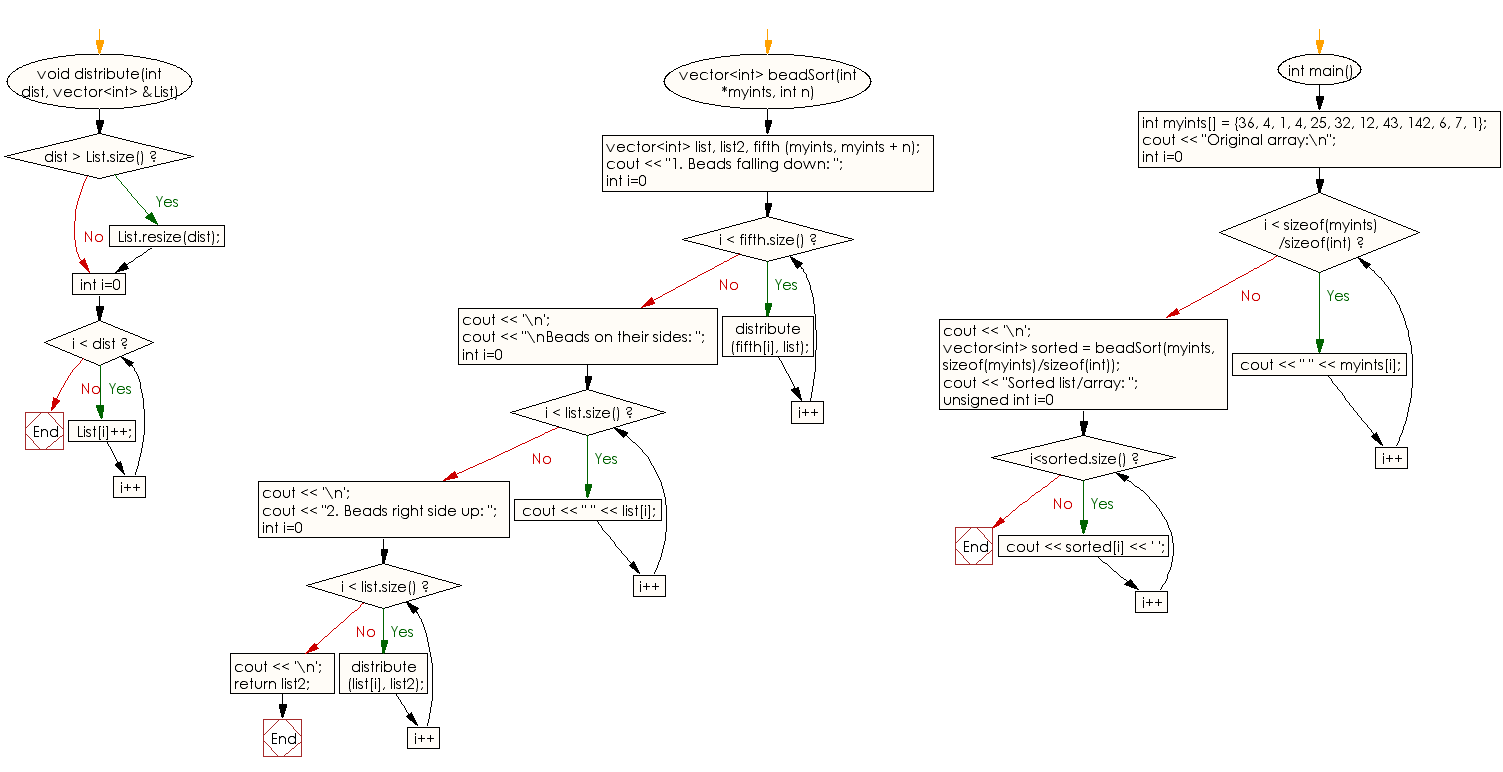C++ Bead sort algorithm Exercise: Sort an array of positive integers using the Bead sort algorithm
2. Sort an Array Using the Bead Sort Algorithm
Write a C++ program to sort an array of positive integers using the Bead sort algorithm.
Sample Solution:
C++ Code :
// Including necessary C++ libraries
#include <iostream>
#include <vector>
// Using specific items from the std namespace for convenience
using std::cout;
using std::vector;
// Function to distribute beads in the beadSort algorithm
void distribute(int dist, vector<int>&List) {
// If the required distribution exceeds the list size, resize the list
if (dist > List.size())
List.resize(dist);
// Increment values in the list for 'dist' positions
for (int i = 0; i < dist; i++)
List[i]++;
}
// Bead sort algorithm implementation
vector<int> beadSort(int *myints, int n) {
// Initializing necessary vectors and copying input values into 'fifth'
vector<int> list, list2, fifth(myints, myints + n);
// Displaying initial values before bead sorting
cout << "1. Beads falling down: ";
for (int i = 0; i < fifth.size(); i++)
distribute(fifth[i], list);
cout << '\n';
cout << "\nBeads on their sides: ";
for (int i = 0; i < list.size(); i++)
cout << " " << list[i];
cout << '\n';
// Further sorting and displaying beads
cout << "2. Beads right side up: ";
for (int i = 0; i < list.size(); i++)
distribute(list[i], list2);
cout << '\n';
// Returning the sorted list after bead sorting
return list2;
}
// Main function
int main() {
// Initializing an array of integers for sorting
int myints[] = {36, 4, 1, 4, 25, 32, 12, 43, 142, 6, 7, 1};
cout << "Original array:\n";
// Displaying the original array values
for (int i = 0; i < sizeof(myints) / sizeof(int); i++)
cout << " " << myints[i];
cout << '\n';
// Sorting the array using the beadSort algorithm
vector<int> sorted = beadSort(myints, sizeof(myints) / sizeof(int));
cout << "Sorted list/array: ";
// Displaying the sorted list
for (unsigned int i = 0; i < sorted.size(); i++)
cout << sorted[i] << ' ';
// Returning 0 to indicate successful execution
return 0;
}
Sample Output:
Original array: 36 4 1 4 25 32 12 43 142 6 7 1 1. Beads falling down: Beads on their sides: 12 10 10 10 8 8 7 6 6 6 6 6 5 5 5 5 5 5 5 5 5 5 5 5 5 4 4 4 4 4 4 4 3 3 3 3 2 2 2 2 2 2 2 1 1 1 1 1 1 1 1 1 1 1 1 1 1 1 1 1 1 1 1 1 1 1 1 1 1 1 1 1 1 1 1 1 1 1 1 1 1 1 1 1 1 1 1 1 1 1 1 1 1 1 1 1 1 1 1 1 1 1 1 1 1 1 1 1 1 1 1 1 1 1 1 1 1 1 1 1 1 1 1 1 1 1 1 1 1 1 1 1 1 1 1 1 1 1 1 1 1 1 2. Beads right side up: Sorted list/array: 142 43 36 32 25 12 7 6 4 4 1 1
Flowchart:

For more Practice: Solve these Related Problems:
- Write a C++ program to implement bead sort on an array of positive integers using a 2D vector for simulation.
- Write a C++ program to simulate bead sort by modeling beads as booleans and printing intermediate states.
- Write a C++ program to perform bead sort and measure the number of steps (simulated gravity iterations) required.
- Write a C++ program to implement bead sort and visualize the “falling” process of beads using nested loops.
Go to:
PREV : Sort Values of Three Variables.
NEXT : Sort a List Using the Bogosort Algorithm.
C++ Code Editor:
Contribute your code and comments through Disqus.
What is the difficulty level of this exercise?
